What is a cyclone filter for a vacuum cleaner: types, structure and operation, pros and cons
When buying a vacuum cleaner for your home, carefully study the technical characteristics and design features, which determine the quality of cleaning and operating conditions. More and more manufacturers are abandoning the dust bag and using a cyclone filter for a vacuum cleaner - a large plastic container in which waste is separated.
What is the operating principle of such a unit, what are its advantages over traditional devices? Let's look at these questions in order, and also give a brief overview of cyclonic vacuum cleaners.
The content of the article:
Vacuum cleaners with cyclone filter
Home cleaning devices differ in the type of dust collector. The description of the model indicates one of the known types: a bag made of non-woven material or paper, an aqua filter or a cyclone filter. The latter option is typical for vacuum cleaners designed for dry cleaning.
Cyclone design features
The first models did not differ in variety: under the lid there was free space where replaceable garbage bags were inserted.
Some were disposable, most often made of paper, others were made of practical material that could be easily washed. The disadvantage of bag units is inconvenient operation.
Over time, this defect was corrected by replacing the replaceable element with a plastic container. It comes in various shapes - cylindrical, cubic, flask-shaped. There are containers that are installed under the lid, others are attached from the outside.
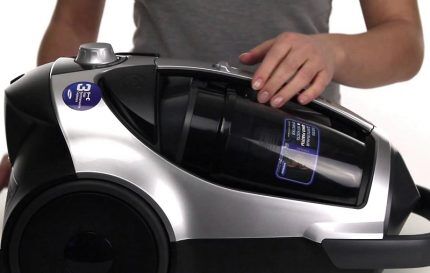
Vertical models do not have a housing on wheels and are similar in design to a mop; they have a cyclone filter located directly on the handle. For traditionally shaped vacuum cleaners, the plastic tank can be located either at the top of the body or at the back.
Let's consider the design using the example of a brand model Hoover.
The lid of the plastic reservoir contains a filter that needs to be cleaned from time to time.
For example, at Samsung it has a spongy structure that quickly becomes clogged with fine dust. A dirty sponge can be easily washed in soapy water - without this procedure, the vacuum cleaner will signal and sharply reduce power.
A cyclone filter can be present in all known types of vacuum cleaners:
- manual;
- vertical;
- ordinary;
- robotic units.
In industrial models, a bulk bag can often be inserted instead of a cyclone filter for cleaning and disposal of construction waste.
Operating principle of the device
In vacuum cleaners with a bag, debris is sucked into the pipe and flows directly into the bag with the air flow.
For devices with a cyclone filter operating principle a bit different. Thanks to the special design of the dust collector, a small powerful vortex is formed, which scatters dust along the walls of the tank and prevents it from returning back into the pipe.
Usually, in addition to the main reservoir, there is a small intermediate compartment where large pieces of debris and hair remain. And the generated air flow pushes fine dust into the main container by centrifugal force.
The result of the work is a filled plastic tank that needs regular cleaning.
Cyclone systems differ between models of different brands, but they are always equipped with a filtration system.
As a rule, meshes or intermediate sections separate large debris, sponges trap fine dust, and a HEPA filter is installed at the outlet and prevents the smallest dust particles from returning back into the room.
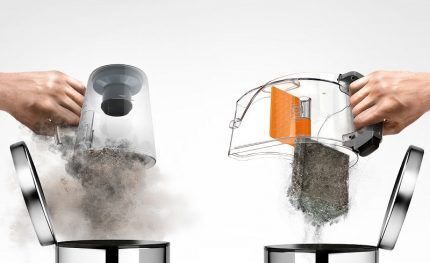
The spiral-shaped movement of air that forms a cyclone filter is used not only in home appliances. Cyclones are used in industrial installations at enterprises to collect powdery substances and the same dust.
Positive aspects of cyclones
Cyclone-type vacuum cleaners owe their popularity precisely to the dust accumulation device. It is designed to prevent dirt from leaving the tank once it gets there.
Advantages of models with a cyclone filter:
- increased work process time thanks to a multi-stage filtration system;
- compactness dust containers;
- ease of maintenance – dust removal occurs quite quickly;
- hygiene – contact with dirt is reduced to a minimum;
- washable and cleaning all parts of the dust collector;
- efficiency, no need to spend money on consumables - bags.
The durable plastic from which containers are usually made is commendable. It does not break from mechanical impact when hard or sharp objects get inside, and the bag can easily tear if a nail or glass accidentally ends up in it.
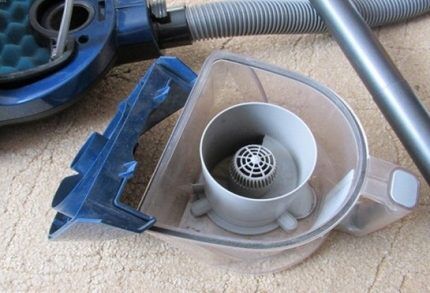
If there is no special full indication, you can judge the amount of debris in the dust collector by the drop in power. As soon as it weakens, it’s time to remove the dust.
Disadvantages of the cyclone device
Users usually learn about the shortcomings of a vacuum cleaner in general and a dust collector in particular during regular use, but it is better to consider some weaknesses before purchasing.
Disadvantages of cyclone filters:
- insufficient power to remove light particles - the smallest dust, fluff, wool;
- possibility of accumulation of static electricity;
- rapid clogging of filters when suction power decreases and centrifugal force weakens;
- increased noise level.
Large pieces of debris and hard objects fall into the plastic container with a loud knock, creating additional noise.
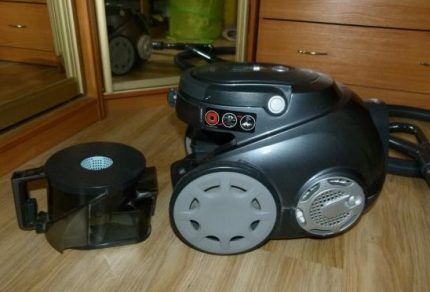
Vertical and compact models with a cyclone filter are not very powerful, so they are not suitable for thorough cleaning. It is better for allergy sufferers to purchase model with aqua filter, purifying not only the floor, but also the air.
Features of caring for a cyclone filter
There are no special recommendations for caring for the cyclone filter - all cleaning operations are carried out simply and intuitively.
With a slight movement, the container is taken out, and the garbage is just as easily poured in. After cleaning, there is no mandatory washing of all parts, as is provided for models with an aquafilter.
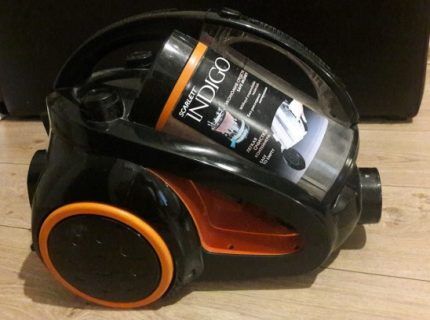
If you still need to wash the tank, just rinse it with clean water. The filters can be washed with laundry soap, the sponges must be carefully wrung out and dried in natural conditions.
If water accidentally gets into the cyclone filter, it also needs to be dried, otherwise the remaining dust will be compressed and clog the holes - the vacuum cleaner will not work as usual or will simply turn off.
Brief overview of brands with cyclone
Devices with cyclone systems are produced by almost all well-known manufacturers of cleaning equipment. Each of them makes its own developments, so both the appearance of the containers and the internal design may differ.
Filters popular cyclones with housing on wheels and suction pipe:
For vertical models, the cyclone filter looks different: it is more compact, weighs less, and, accordingly, is not as productive as its conventional floor-standing counterparts.

When purchasing a unit with a cyclone filter, the same rules apply as for choosing any cleaning equipment: power, weight, additional functions, the presence of a battery, and the ability to operate in automatic mode (for robots) are taken into account.
If you need regular high-quality dry cleaning, devices with a cyclone dust collection system are suitable - powerful, inexpensive, and easy to clean.
Some craftsmen have gotten the hang of assembling a cyclone separator themselves and connecting it to conventional bagged vacuum cleaners. Detailed instructions for creating such a device are given in this article.
Conclusions and useful video on the topic
Operating principle of the cyclone device:
Comparative review of cyclone and bag models:
Features of operation of the cyclone model and the device with an aquafilter:
When choosing a model with a cyclone, be sure to make sure that the filter is reliable: it should last as long as the vacuum cleaner is designed for. Cheap models are made from fragile, unreliable materials, so it’s better to overpay a little and get a product with a durable container and a high-performance filter.
Do you have experience using a cyclone vacuum cleaner? Or want to ask questions on the topic? Please comment on the publication, share your experience of using such units and participate in discussions - the feedback block is located below.




I don't notice any serious shortcomings in the filters. The noise comes from the vacuum cleaner motor, it collects hair and dust well, I have never been shocked. The most convenient thing, this filter.Removable with one hand, easy to clean, wash and dry instantly. The only thing that causes difficulties is the foam damper that protects from dust; it must be cleaned and washed regularly.
As far as I see, vacuum cleaners with cyclone filters are a new stage in the development of cleaning technology. I like that these vacuum cleaners have good suction power. The truth is that it falls as the container fills. Another disadvantage is that after each cleaning the filters have to be washed and dried. But the pros, it seems to me, outweigh the cons. I am planning to buy myself such a vacuum cleaner.
It’s very annoying that you have to clean the filters two or three times during cleaning. They become clogged very quickly in a cyclone vacuum cleaner and therefore the draft drops significantly. And if you wash the filters, then cleaning will have to be postponed for 24 hours until they dry, since wet filters cannot be used... The vacuum cleaner filters have crawled into trash within a year. New ones cost $20. Savings are in doubt. You have to be a coward and wash the filters with your own hands - it’s terribly disgusting... But while my friends don’t know this, they’re terribly jealous)))
I have been using a vacuum cleaner with a Karcher aqua filter for 7 years. If I had to buy it now I would buy the same one